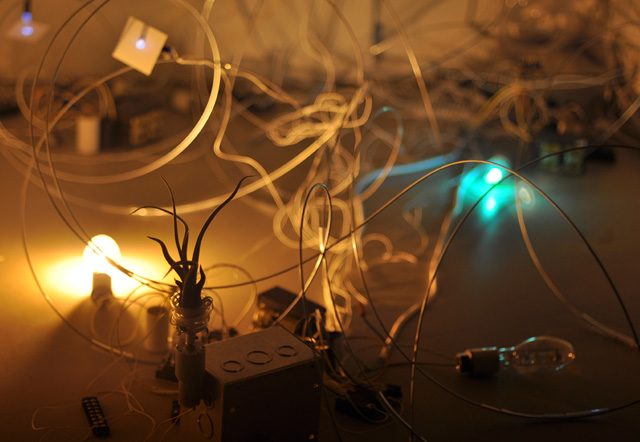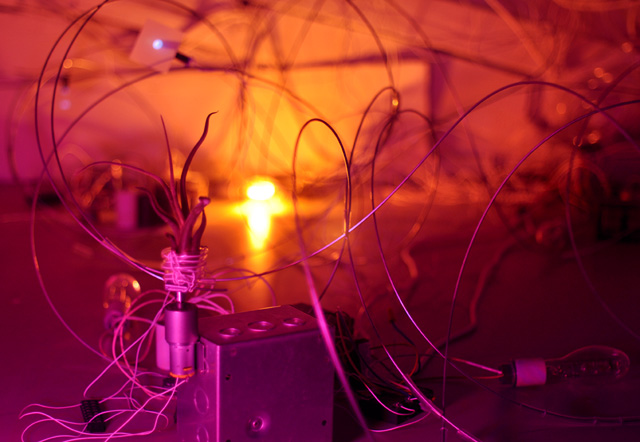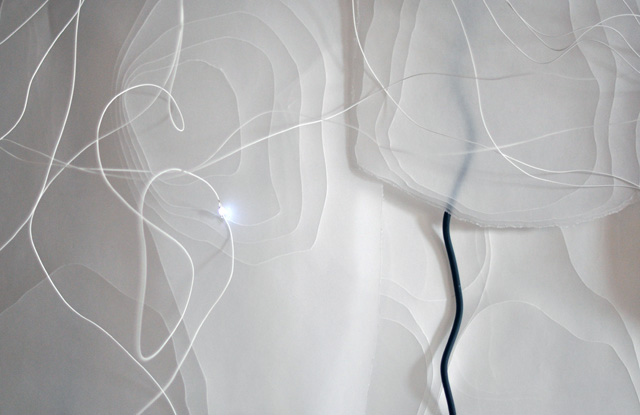a drift, a tempo / electro-acoustic music and live video capture.
Category: projects
tiento
our electro-magnet setup in sunlight on a cloudy, winter day. we made a live performance incorporating this work and including some of our glass objects called ballade (below). here is a link to ballade and our other sound recordings on soundcloud.
ballade
live performance with handmade glass objects and electro-magnets. the electro-magnet setup appears on its own in ballade, the video and sound piece above, and with our other works on vimeo here.
pilchuck glass school residency documentation
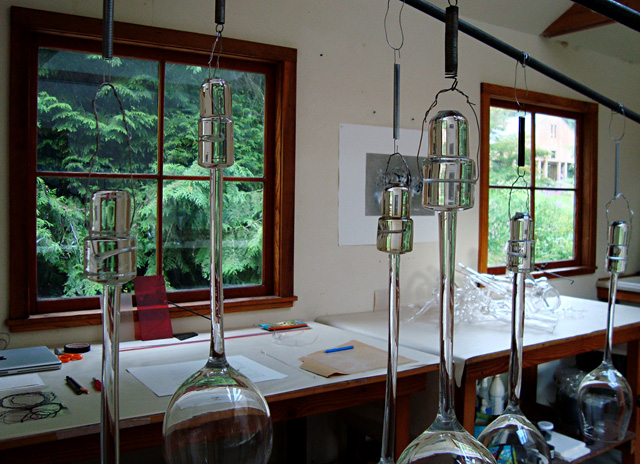
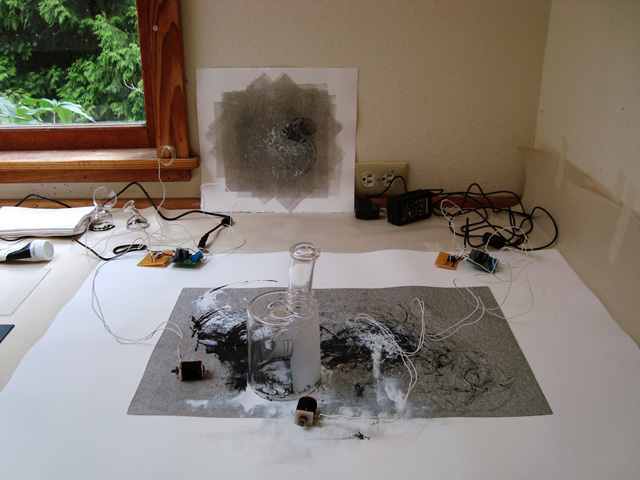
click here for the complete set on Flickr
During our residency at Pilchuck Glass School, we expanded on work started at the Museum of Glass and we developed a series of new works involving sound making objects, printmaking and drawing. We gave two performances during our residency, and some of our printmaking was exhibited during November 2014 at the Pilchuck Glass School Exhibition Space. Additional documentation of our performances and print process are linked below.
Our sound work with glass involves the creation of shapes that can be bowed or struck to produce fundamental pitches and harmonics so that one instrument can sound more than one pitch. Working carefully with our expert gaffers, Manny Krakowski and Netty Blair, we were able to make several variations of vessel shapes that each produced a complex spectrum of tones. We were also able to develop methods of linking two or more objects on a rocking base so that two objects could be played simultaneously by one player and variations on timbre and attack through bowing, striking, rocking were possible.
For our performances we grouped objects in terms of their tunings and timbres making tuning changes (by reshaping, or filling vessels with water) where necessary to create a specific temperament. Once we created a temperament we improvised extensively with it and developed compositions for it. Our compositions are a mix of rehearsed sections/gestures connected by improvisation. While we usually decide how to start and end, the pieces are largely determined during the performance.
In both our sound and print work we used electro-magnet/neodymium magnet setups where the magnets moved in response to changes in the polarities of our electro-magnets that were triggered by fluctuations in the EMF of the space where they were.
As sound, the clinking/tapping of the magnets against glass added a percussive, chaotic element to our compositions; something that fueled our improvisations as the magnets never behaved the same way in each performance.
For the prints, we used the same set of circuitry, vessels and magnets, but as mark making elements. We set the magnets up on inked plates and let them roll until they were covered in ink and had left marks on the plates. We then made several prints with the plates, and then placed the electro-magnet setup on the prints’ surface in the same configuration and let the neodymium magnets deposit the ink they had previously gathered. Freshly inked magnets were also added in the process. As with the sound pieces, the electro-magnet’s polarity oscillates in response to changes in EMF around them.
Our drawings incorporate variations on the shapes of the goblet and the vessel, primary glassblowing forms that suggested to us the physiology of the inner ear. The drawings functioned as non-dimensional starting points for the development of our sculptural and sound making objects.
Our time at Pilchuck was special and we are grateful to the long list of wonderful people who made our experience so memorable including Tina Aufiero, Rebecca Arday, Jim Baker, Ben Wright, our gaffers Manny Krakowski and Netty Blair, our assistants Keunae Song and Anna Masowsky, Alex Gibson in the printshop, Rebekah Birkan, who constructed the amazing frame for the goblets from found metal in the Pilchuck metal shop and Zach Lorenzetti who made music with us and assisted behind the wheel!
à la vitesse de ton souffle
more details for the work are on the vimeo page.
Influenced by our time walking in and around Paris, La Générale and the jardins de Versailles, à la vitesse de ton souffle is an installation in the form of a sequence of compositions and spaces made of sound, light, objects and movement, activated by visitors walking through the gallery at the speed of their own breathing. Each composition oscillates and slips between various binaries: formal and semiotic, interior and exterior, found and placed, organic and artificial, operand and operator. à la vitesse de ton souffle is a perambulation in a twilight heterotopia of green and pink noise.
Influencés par le temps passé à nous promener dans et autour de Paris, La Générale et les jardins de Versailles, à la vitesse de ton souffle est une installation qui prend forme dans l’ordre des compositions et des espaces créés par le son, la lumière, les objets et les mouvements, activés par les visiteurs qui se déplacent dans l’espace à la vitesse de leur respiration. Chaque assemblage oscille et glisse entre diverses dualités : formel et sémiotique, intérieur et extérieur, trouvé et placé, organique et artificiel, opérant et opérateur. à la vitesse de ton souffle est une pérambulation dans un crépuscule hétérotopique d’un bruit vert et rose.
au concert printemps flottant
au concert printemps flottant was shown at the palais de tokyo as part of concert hall, a large collaborative work included in nouvelle vagues.
au concert printemps flottant is a kinetic installation composed of organic and industrial materials, including a live tillandsia medusa, a custom LED grow light, a motor, and commercial gas vapor street lights, among other materials. a micro-controller regulates movement and changes in lighting intended to both sustain the tillandsia and reveal a sequence of 26 short variations in movement and light over 11 minutes. au concert printemps flottant was built and programmed on-site during the installation period for nouvelle vagues’ concert hall and was influenced by, and references, the themes of music, play and integration at the heart of this exhibit.
the materials include: tillandsia caput-medusa, electronics, plastic tubing, metal springs, custom electric light, vellum, wood, paint.
the dimensions of the work are approximately 10’x20’x15′.
for the flickr set click here.
images from die Botschaft show on flickr
we just posted images from our show at die Botschaft, take a look!
new works:
mottetto
quine
inversi
resonance
rapport
rounded binary
video will follow shortly.
die Botschaft 1628, a private gallery
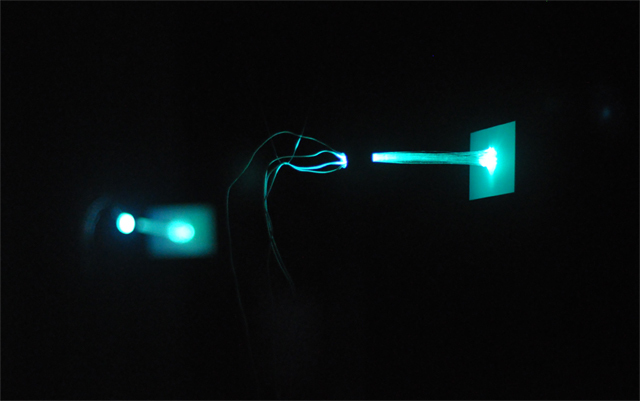
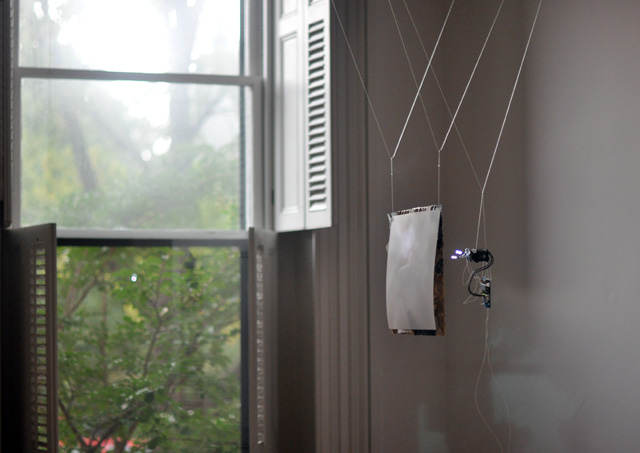
we have a show at a private gallery in baltimore, md, called die Botschaft 1628, owned by marcia hart. the show runs until september 23, features 6 new works and is available by appointment only. none of the work is for sale, there was no opening and no hype. we had several salon style discussions and visits with interested viewers.
prior to our show we weren’t aware of people dedicating parts of their homes to occasional, private art exhibits.
the experience has been wonderful. before this opportunity we began the summer developing several works with no idea where they would eventually be shown – happily devoting our time to our work and process. in may we met marcia and visited die Botschaft 1628 and had a few subsequent discussions over the summer that lead to the opportunity.
we structured our time as a residency with an accompanying exhibit. we completed the works begun in our studio on-site, conditioned by the gallery and after the works were completed, were able to spend mindful time with interested visitors and get their feedback. we gave a few gallery talks to small groups and had easy access to the space while managing when visitors would be there. we were able to visit the work privately to look at it installed at different times of the day (the gallery has two large windows so the lighting conditions change dramatically), document and learn from it.
the title we chose for the show was: a silent evocation of the society for private musical performance – a reference to the salon chamber music society of vienna in the early 20th century. that society was designed to permit a diverse array of new concert music the chance to be heard in an educated, critical environment of careful listening and thought (often works were performed twice on the same evening) as a foil to mounting public and journalistic confusion of popular trends, entertainment and privilege with art that were contributing to a harsh environment for the evolution of music as an art form.
our time at die Botschaft 1628 has shown us an ideal exhibition paradigm for our art practice and process, and we’ll leave the gallery focused and inspired. we’re writing about this because there may be others out there who feel similarly, either potential private gallerists or artists and this may serve as an impetus to a deeply rewarding experience.
we’ll be posting documentation of our work here in the coming weeks.
through continuo
composed of electronics and paper, through continuo is a work for the Brooklyn Zen Center’s No-Eyes Viewing Wall, and part of the Silence and Noise exhibit (April 13-September 29, 2012), co-curated by Noah Fischer and Terence Caulkins.
through continuo is installed on the walls and ceiling of the gallery. the dimensions of the work on the wall are approximately 9’x16′, there are five small piezo speakers coupled with glass mueller tubes suspended from the high ceiling in front of the work by approximately 3′ – one needs to look up to see them. the speakers/mueller tubes occupy roughly the same space as the wall installation. shadows from the components installed in the ceiling (including wiring) form changing compositions with the circuitry, wiring and paper mounted on the wall. the gallery has large windows so the lighting conditions change throughout the day. the piece is lit with a mix of electric and natural light. the work emits very quiet sounds from its piezo speakers. the amplitude of the audio is intentionally on the threshold of hearing, and the placement of the speakers creates a spacialized listening experience. small, white LEDs with varying brightness and frequency (described below) and white wires are integrated into the paper mounted on the wall. the paper has been embossed by hand.
through continuo is a constellation of events. some are random: gamma-ray detection and the presence and behaviors of visitors, and some are composed: the sonification of the gamma-rays (the very quiet pops and clicks one hears around the work, emanating from piezo speakers mounted in the ceiling), the look of the installation, and the changing frequencies of the LEDs. “frequencies” of the LEDs refers not to the brightening and dimming, but to the changing rates of pulsation. this feature of the work is very difficult to document.
gamma radiation detected by our sensors are transposed into sound and light. the relationship between the gamma-ray detection and the pops and clicks of sound is linear, 1:1. the relationship between the soft pops and clicks to changes in the frequencies of the LEDs is statistical, non linear. each led has its own pattern of brightening, dimming, and pulsating, and those behaviors are influenced by a statistical analysis of gamma-ray detection in real time.
essentially, the work has linear and logarithmic relationships based on random events. for the viewer, this creates an experience that oscillates between one’s impulse to understand events as sequential/temporal and a work that is inherently spectral, i.e., based on persistent, shifting frequencies.
in the context of binary title of this show, Silence and Noise, we’re thinking about time and frequency, and how one’s experience is persistently both, but how from an increasing number of perspectives time is an illusion unique to the human mind. the universe, it seems, is not sequence, it is waves – but we are wired so that to us its always both. in through continuo the linear relationship between the gamma-ray events and the audible clicks is a noise element in that it evokes the temporal mind, and the silence is the silence of the visible change in LED frequency.
the Silence and Noise effect is that the work itself is an oscillation, a wavelet and an interval between the two.
we’ll be posting video and an audio recording soon.
for more images go here.
120/108
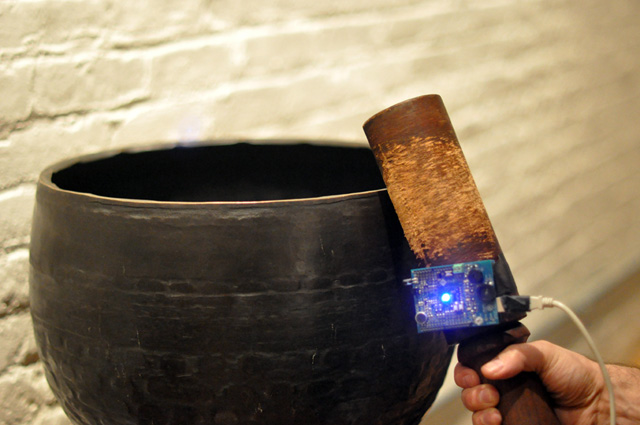
120/108 is a sound and movement work done in collaboration with Terence Caulkins. it was realized as part of the opening performance for Silence and Noise at the Brooklyn Zen Center (April 13, 2012), co-curated by Noah Fischer and Terence Caulkins. Silence and Noise, for which we also have a sculptural work, will run through September 29, 2012.
120/108 began as a study on the acoustical properties of a large, singing bell that resides in the zendo (meditation space) of the Brooklyn Zen Center and has a primary role in services at the center.
the analysis of the bell extended to an analysis of how its sounds propagated through the zendo, and how different acoustical properties of the bell, its frequencies, and those of the zendo were revealed at different locations within the space.
the work we composed utilizes various acoustical phenomena evoked by striking and rubbing the bell, as well as resonating it with sine waves. we developed an interface to synchronize contact with the bell with software and permit real time communication between the two.
the piece was experienced by walking slowly through the space as practiced with kinhin (walking meditation). visitors followed a pre-determined path intended to slowly reveal each element of the composition. additional performances over summer ’12 are being planned.
the title refers to the primary frequency of the bell and the number of interactions with it during the performance.
